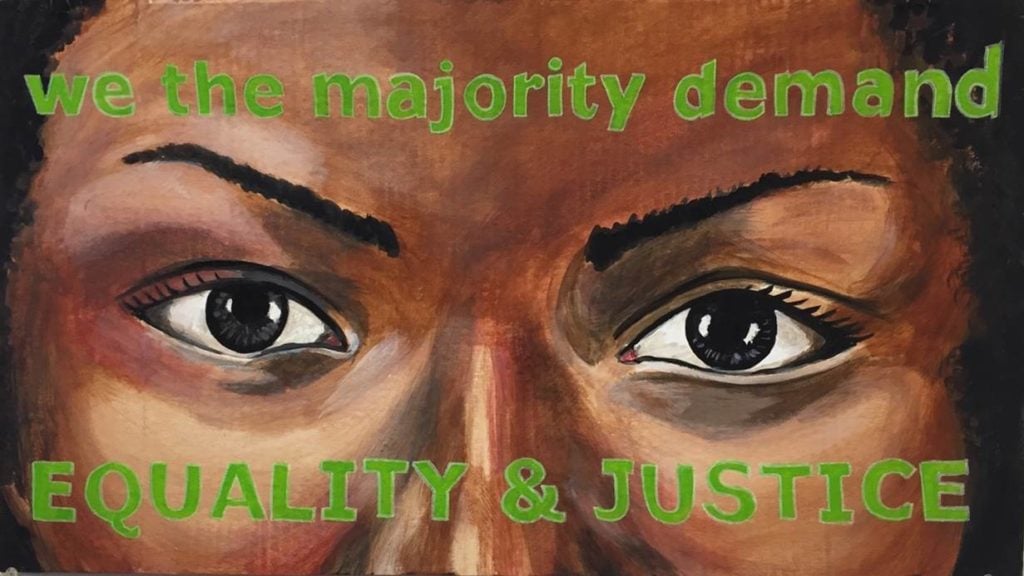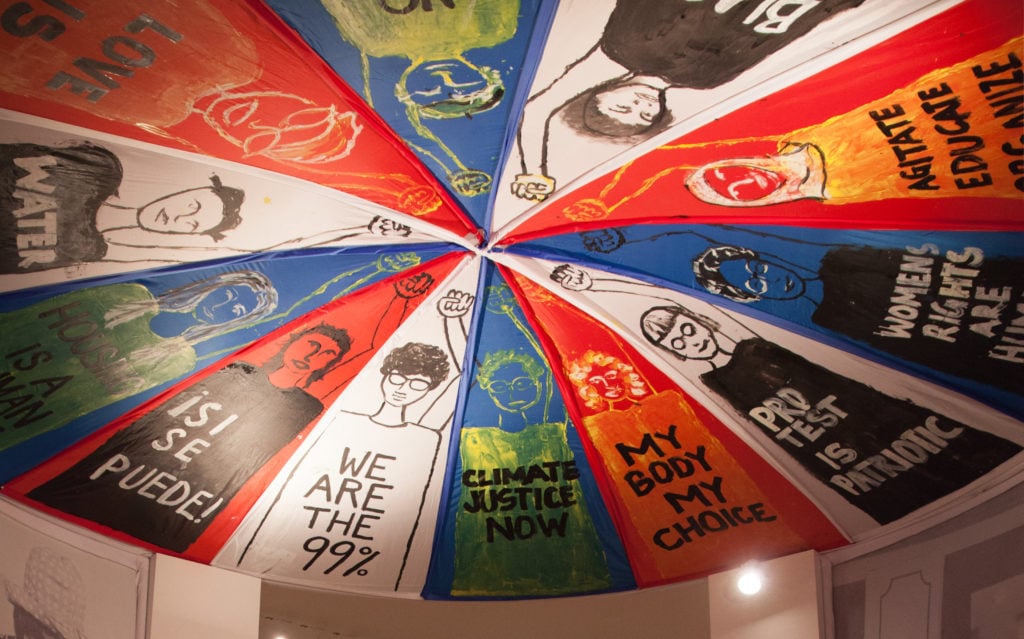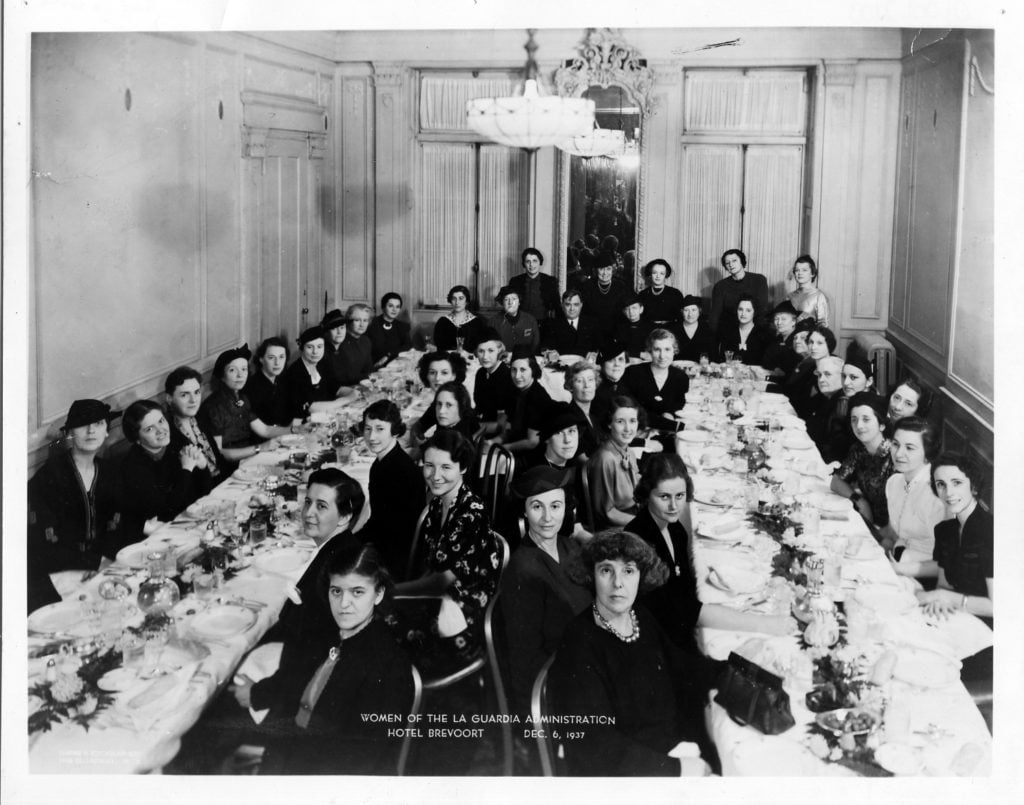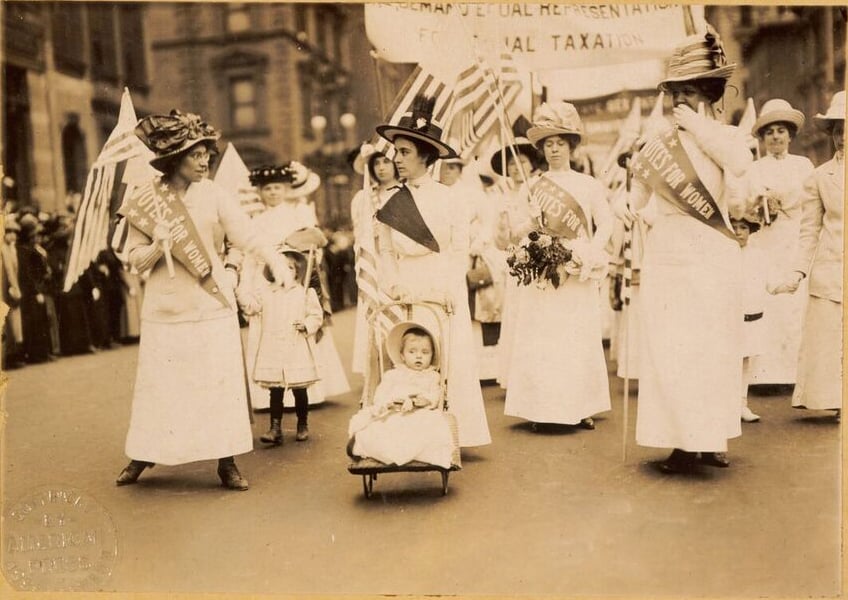On View
From Suffrage to the Women’s March, a New Exhibition Celebrates 100 Years of New York Women in Politics
New York granted women the right to vote on November 6, 1917.

New York granted women the right to vote on November 6, 1917.

When it comes to women’s rights, New York has always been a hotbed of political activism. That rich history is the basis for “Beyond Suffrage: A Century of New York Women in Politics,” a new exhibition at the Museum of the City of New York.
Originally planned to coincide with the 100th anniversary of the state’s women winning the right to vote, which is November 6, the show took on new significance in the wake of the election of President Donald Trump. The city, and indeed the world, took to the streets for the Women’s March following Trump’s inauguration in January and again on International Women’s Day in March.

A parachute depicting historically significant American woman designed by Elizabeth Hamby for the
2017 Women’s March in New York. It is now on view in “Beyond Suffrage” at the Museum of the City of New York. Courtesy of Michael James Wilson.
Following those historic events, the city museum put out a call for donations, asking participants in the New York demonstrations to contribute signs, banners, and other artworks they had made for either occasion. Those signs join historic political ephemera from the museum’s collection in the show, echoing the voices of previous generations in their call for women’s rights.
“Progress is not some linear thing,” said exhibition curator Sarah Seidman, the museum’s curator of social activism, to artnet News at the press preview. Across the past century, “it’s been the same movement, the same challenges, the same issues that people are fighting over.”

The entrance to “Beyond Suffrage” at the Museum of the City of New York. Courtesy of Michael James Wilson.
Seidman has illustrated this point at the entrance to the show, where photos of the 1917 parades in support of women’s suffrage are displayed alongside images of protestors from this year.
Separated by 100 years, the juxtaposition is striking. Where just a few women, clad in long white dresses and carrying placards, marched in orderly rows a century ago—a truly unusual sight for the era—the crowds clogged the streets this January, a sea of humanity out in support of women’s rights.
The rest of the exhibition is organized chronologically, covering the suffrage movement, the seldom-recognized women working in government in the decades that followed, the women’s liberation movement, and through to present-day activism.
The show also highlights some of the leading figures of the period, from familiar names like Elizabeth Cady Stanton and Gloria Steinem to those who have been largely overlooked by history, such as Mary Lilly, who became the first New York City woman elected to office when she won her Assembly race in 1918.

Women of the La Guardia administration dinner (1937). Courtesy of the La Guardia and Wagner Archives, F. H. La Guardia Collection.
“It is a challenge to find objects from and images from these women who have really been forgotten by history,” said Seidman.
Regardless of their place in the history books, the women of New York played a key role in the history of the nation.
“If we win the Empire State… all the states will come tumbling down like a pack of cards,” reads a quote on the exhibition wall from Harriet Stanton Blanch, daughter of Cady Stanton and the second in the family’s three generations of prominent New York activists for women’s rights highlighted in the show.
While the exhibition focuses primarily on the history of hard-fought progress, it also highlights opposing movements, which have always included women. Artifacts on view expressing opposition to suffrage include a political cartoon and buttons, underscoring the reality that, in many ways, people are contesting the same issues 100 years later.
The show also acknowledges fissures within the push for women’s rights, which has not been immune to racism. A century-old photo offers a particularly clear example. Titled Youngest Parader, a cute toddler in a pram is shown being accompanied by a white woman, who appears to be glaring at a black suffragette marching alongside her.

Youngest parader, American Press Association (1912). Courtesy of the Library of Congress, Prints and Photographs Division, LC-USZC4-5585.
In each section, the museum features important historical artifacts, such as a voting machine featuring the original ballot that proposed giving the vote to women.
Of more recent vintage, you can also see Hillary Clinton’s pantsuit from when she was sworn in as New York’s junior senator in 2001, and the white dress New York Senator Geraldine Ferraro wore the night she was nominated as vice president in 1984, becoming the first women included on the ticket of a major party.
Among the most compelling objects on view are the artworks from the different periods. There is a proof of a design for a new Working Women’s Dollar bill promoting equal wages, designed by Kat Brennan and the Creative Women’s Collective back in 1978, with a portrait of suffragette Susan B. Anthony. At the time, women only earned 57 cents on the dollar compared to men.
Also from the women’s liberation era is a poster created by Marlene McCarty for the Women’s Action Coalition, reading “WAC Is Watching.”
From the ’30s, Seidman has selected a banner from Rebel Arts, a socialist cultural group that pushed for equality for both women and minorities. Stretching back even further, there is Rollin Kirby’s historic political cartoon, “The End of the Climb,” which shows the suffragette triumphant. Unfortunately, Kirby’s hopeful proclamation proved extremely premature.
In the exhibition’s center, there is an informal polling station, asking viewers to share their views on women’s issues. Above hangs a parachute, each colored segment painted with a portrait of a historically significant woman and a pro-woman slogan. Created by Elizabeth Hamby, it was carried aloft at the Women’s March in New York this year. Paired with the reminder of Clinton’s loss, it serves, said Seidman, as a way of “acknowledging we still have a long way to go in terms of equity.”
“Beyond Suffrage: A Century of New York Women in Politics,” a new exhibition at the Museum of the City of New York, 1220 Fifth Avenue at East 103rd Street, October 11, 2017–July 22, 2018.